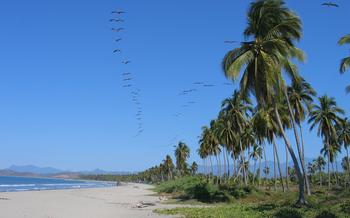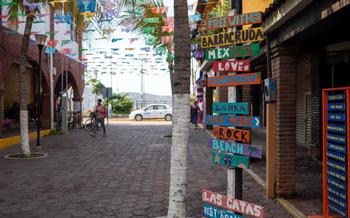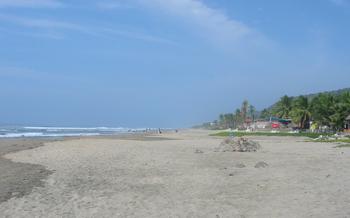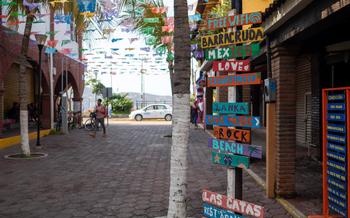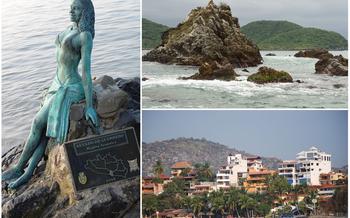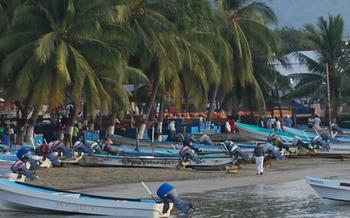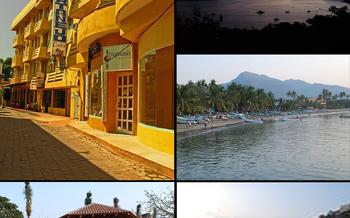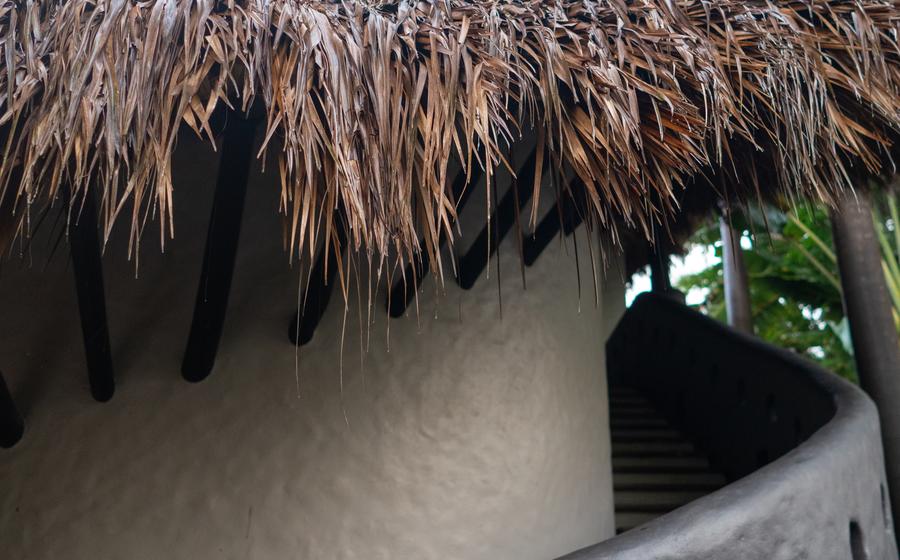
Playa Larga Sea Turtle Release
- Zihuatanejo's Enchanting Beach Town
- Playa Larga: A Sanctuary for Sea Turtles
- When to Visit Playa Larga for the Sea Turtle Release
- Preparing for Your Visit to Playa Larga
- The Sea Turtle Release Process
- Fascinating Facts about Sea Turtles
- Additional Conservation Efforts in Zihuatanejo
- Exploring Zihuatanejo's Other Charms
- Getting to Zihuatanejo
- Where to Stay in Zihuatanejo
- What to Eat in Zihuatanejo
- Safety Tips for Travelers:
- Cultural Insights and Etiquette:
- Insider Tip: Supporting Local Conservation
Zihuatanejo's Enchanting Beach Town
Nestled along Mexico's picturesque Pacific coast, Zihuatanejo is a charming beach town that has transformed from a tranquil fishing village into a vibrant tourist destination. Its cobblestone streets, adorned with colorful buildings, exude a unique charm that captures the essence of traditional Mexican culture. Zihuatanejo's laid-back atmosphere invites visitors to immerse themselves in the town's relaxed rhythm, while its stunning beaches, exciting water sports opportunities, and delectable seafood restaurants offer a plethora of unforgettable experiences. As you stroll through Zihuatanejo, you'll discover hidden gems, encounter friendly locals, and create lasting memories in this enchanting beach paradise.
Playa Larga: A Sanctuary for Sea Turtles
Playa Larga is a significant nesting site for sea turtles due to its pristine coastline, abundant food sources, and protection from strong waves. Four species of sea turtles grace the shores of Playa Larga: the Olive Ridley, Green, Hawksbill, and Leatherback. These majestic creatures undertake incredible journeys across vast oceans to return to their birthplace to lay their eggs.
Sea turtles face numerous threats to their survival, including habitat loss, pollution, and overfishing. The destruction of nesting beaches, entanglement in fishing gear, and ingestion of plastic waste pose significant risks to these ancient mariners. Playa Larga's protected status and conservation efforts create a safe haven for sea turtles to nest and reproduce, contributing to the survival of these endangered species.
Local conservation organizations play a crucial role in safeguarding Playa Larga and its sea turtle population. Their tireless efforts include nest monitoring, predator control, and habitat restoration. By supporting these organizations through donations, volunteering, or responsible tourism practices, visitors can contribute to the preservation of this unique and fragile ecosystem.
When to Visit Playa Larga for the Sea Turtle Release
The best time to visit Playa Larga for the sea turtle release is during the nesting season, which typically runs from July to November. This is when the majority of hatchlings emerge from their nests and make their way to the ocean.
To ensure that you don't miss this incredible event, it's important to check with local conservation organizations for specific dates and times of the sea turtle releases. These organizations can provide up-to-date information on the nesting activity and the best time to visit.
When planning your trip, it's advisable to book accommodation and transportation in advance, especially if you're visiting during the peak season. This will help you avoid any last-minute surprises and ensure that you have a smooth and enjoyable experience.
Preparing for Your Visit to Playa Larga
Venturing to Playa Larga for the sea turtle release demands adequate preparation. Begin by packing comfortable footwear, for you'll be traversing sandy terrain. Fend off pesky insects with repellent, and don't forget your camera to capture the spectacle.
Dress appropriately for the beach, considering the possibility of both sun and rain. Respect the rules and regulations of the sea turtle release. Maintain a safe distance from the turtles, allowing them undisturbed passage to the ocean. Refrain from using flash photography, as it can disorient and harm the hatchlings.
The Sea Turtle Release Process
The sea turtle release process is a delicate and fascinating procedure that involves multiple steps to ensure the safety and well-being of the hatchlings.
Egg Collection: Conservationists carefully collect sea turtle eggs from their nests on the beach, ensuring minimal disturbance to the nesting site.
Incubation: The eggs are placed in a secure hatchery or incubator, where they are monitored and protected from predators and harsh weather conditions.
Hatching: Once the eggs hatch, the baby turtles, known as hatchlings, emerge from their shells and instinctively crawl towards the light, often guided by the moonlight or starlight.
Health Check: Before the release, each hatchling undergoes a health check to ensure they are strong and healthy enough to survive in the ocean.
Release: At dusk or dawn, when the beach is quiet and free from predators, the hatchlings are gently carried to the shoreline and released into the ocean. The hatchlings instinctively swim towards the open sea, guided by their natural instincts and the waves.
Monitoring: Conservationists monitor the release to ensure the hatchlings successfully enter the ocean and are not disturbed by predators or other factors.
Participating in a sea turtle release is an emotional and rewarding experience that allows visitors to contribute directly to the conservation of these magnificent creatures.
Fascinating Facts about Sea Turtles
Sea turtles are truly remarkable creatures with a fascinating life history and unique adaptations for marine life. Here are some intriguing facts about these ancient mariners:
-
Lifespan: Sea turtles have incredibly long lifespans, with some species living for over 80 years. This makes them one of the longest-lived vertebrates on Earth.
-
Migration Patterns: Sea turtles are renowned for their epic migrations, traveling thousands of miles across oceans to find suitable feeding and nesting grounds. Some species, like the Leatherback turtle, can migrate up to 10,000 miles per year.
-
Unique Adaptations: Sea turtles possess several unique adaptations that allow them to thrive in the marine environment. Their streamlined bodies and powerful flippers enable them to swim long distances with grace and efficiency. Additionally, their hard shells provide protection from predators, and their ability to hold their breath for extended periods allows them to dive deep in search of food.
-
Role in Marine Ecosystems: Sea turtles play a crucial role in maintaining the health of marine ecosystems. As predators, they help control populations of jellyfish, sponges, and other invertebrates. Their feeding habits also contribute to nutrient cycling and the overall health of coral reefs and seagrass beds.
-
Threats to Survival: Despite their resilience, sea turtles face numerous threats to their survival. Habitat loss due to coastal development, pollution, entanglement in fishing gear, and climate change are among the most significant challenges they encounter. These threats have led to a decline in sea turtle populations worldwide, making conservation efforts more critical than ever.
Additional Conservation Efforts in Zihuatanejo
Zihuatanejo's commitment to conservation extends beyond sea turtles. The town is also home to various other conservation initiatives aimed at preserving the region's natural beauty and biodiversity.
One notable project is the coral reef restoration program, which focuses on rehabilitating damaged coral reefs and promoting the growth of new ones. Coral reefs are vital ecosystems that provide food and shelter to a diverse array of marine life, and their health is essential for the overall balance of the marine environment.
Another important conservation effort in Zihuatanejo is mangrove conservation. Mangroves are coastal forests that play a crucial role in protecting shorelines from erosion, filtering pollutants from the water, and providing habitat for various wildlife species. The conservation of mangroves is vital for maintaining the ecological balance of the coastal ecosystem.
Local communities are actively involved in these conservation efforts, recognizing the importance of preserving their natural heritage for future generations. The involvement of local communities ensures that conservation efforts are sustainable and aligned with the needs and interests of the people who live in the area.
As a visitor to Zihuatanejo, you can support conservation efforts through various means. Consider volunteering your time with local conservation organizations, making donations to support their work, or choosing tour operators that contribute a portion of their proceeds to conservation projects. By doing so, you can contribute to the preservation of Zihuatanejo's natural wonders and ensure that future generations can enjoy the same pristine environment that you experienced during your visit.
Exploring Zihuatanejo's Other Charms
Beyond the sea turtle release, Zihuatanejo offers a plethora of other experiences to enrich your visit. Immerse yourself in the vibrant local culture by exploring the bustling markets, where you can haggle for unique souvenirs and sample mouthwatering street food. Indulge in the flavors of traditional Mexican cuisine at one of the many charming restaurants, where you can savor fresh seafood dishes and aromatic mole sauces. Embark on a thrilling boat trip to nearby islands, where you can snorkel amidst colorful coral reefs, sunbathe on pristine beaches, and spot playful dolphins.
As night falls, Zihuatanejo transforms into a vibrant hub of activity. Discover the town's lively nightlife scene by hopping between bars, clubs, and live music venues, where you can dance the night away to the rhythm of salsa, merengue, and reggae. For a more laid-back experience, take a leisurely stroll along the picturesque waterfront, enjoying the cool evening breeze and admiring the twinkling lights reflecting on the water.
Uncover the hidden gems and off-the-beaten-path experiences that make Zihuatanejo so special. Venture beyond the main tourist areas to find secluded beaches, tranquil waterfalls, and charming villages nestled in the lush surrounding mountains. Engage with the friendly locals, who are always eager to share their stories and traditions. Embrace the opportunity to learn about the rich history and culture of this enchanting Mexican town.
Getting to Zihuatanejo
Zihuatanejo is conveniently accessible by air, land, and sea. The Ixtapa-Zihuatanejo International Airport (ZIH) is just a short drive from both Zihuatanejo and the neighboring resort town of Ixtapa. Several major airlines offer direct flights to ZIH from various cities in the United States, Canada, and Mexico.
For those who prefer to travel by land, Zihuatanejo is connected to other parts of Mexico by a well-maintained highway system. Buses are a popular and affordable option, with frequent departures from major cities like Mexico City, Acapulco, and Guadalajara. Renting a car is another great way to explore the region at your own pace.
If you're coming from a nearby destination, such as Ixtapa or Acapulco, you can also take a scenic boat trip to Zihuatanejo. Several tour operators offer day trips and sunset cruises that provide breathtaking views of the coastline and the opportunity to spot dolphins, whales, and other marine life.
To find the most affordable and convenient transportation options, it's a good idea to research and book your tickets or reservations in advance, especially during peak tourist season.
Where to Stay in Zihuatanejo
Zihuatanejo offers a wide range of accommodation options, catering to different budgets and preferences. From budget-friendly hostels to luxurious beachfront resorts, there's something for every traveler.
For those seeking an authentic Zihuatanejo experience, consider staying in a small, family-run hotel or guesthouse. These charming establishments often offer a more personal touch and allow guests to immerse themselves in the local culture.
If you prefer the comfort and amenities of a larger resort, Zihuatanejo has several options to choose from. These resorts typically offer private beaches, swimming pools, restaurants, and spas, providing a relaxing and pampering stay.
To find the best deals on accommodation, it's advisable to book in advance, especially during peak season. Online booking platforms and travel agents can help you compare prices and find the best deals.
Here are some recommendations for hotels and guesthouses in Zihuatanejo:
- Budget-friendly:
- Hotel Irma: A charming family-run hotel with basic but comfortable rooms.
-
Hostal Zihuatanejo: A friendly and social hostel with dorm rooms and private rooms available.
-
Mid-range:
- Hotel Villa del Sol: A cozy hotel with a rooftop terrace and stunning views of the bay.
-
Casa de la Tortuga: A small hotel with a relaxed atmosphere and a focus on sustainability.
-
Luxury:
- Las Brisas Ixtapa: A luxurious resort with private villas, a world-class spa, and multiple restaurants.
- Azul Ixtapa Grand: A beachfront resort with elegant rooms, a large pool, and a variety of dining options.
What to Eat in Zihuatanejo
In Zihuatanejo, satisfying your taste buds is as essential as soaking up the sun and sand. The town's culinary scene is a vibrant blend of traditional Mexican flavors and fresh seafood caught daily from the Pacific Ocean.
Must-Try Dishes
-
Fresh Seafood: Zihuatanejo's proximity to the ocean means that seafood is always on the menu. Try the grilled fish tacos, ceviche tostadas, or the local specialty, pescado zarandeado—a whole fish grilled over an open fire and served with a tangy sauce.
-
Traditional Mexican Cuisine: Don't miss the chance to savor authentic Mexican dishes like pozole, enchiladas, and mole, a rich and flavorful sauce made with various chilies, spices, and chocolate.
-
Local Delicacies: For a unique culinary experience, try the local delicacy, iguana en adobo, a stew made with iguana meat cooked in a spicy adobo sauce. Or, indulge in the sweet temptations of Zihuatanejo's homemade ice cream and sorbet, made with fresh tropical fruits.
Recommended Restaurants
-
El Delfin: A Zihuatanejo institution known for its delicious seafood dishes, especially the grilled octopus and coconut shrimp.
-
La Perla: A charming restaurant serving traditional Mexican cuisine with a modern twist, using fresh local ingredients.
-
La Sirena Gorda: A casual beachfront spot perfect for enjoying fresh ceviche, fish tacos, and cold beer while basking in the ocean views.
Tips for Foodies
-
Vegetarian and Vegan Options: While Zihuatanejo's cuisine is predominantly seafood-focused, there are options for vegetarians and vegans. Look for restaurants that offer grilled vegetables, salads, and bean-based dishes.
-
Avoid Tourist Traps: To experience the authentic flavors of Zihuatanejo, venture beyond the main tourist areas and explore the local markets and small family-run restaurants.
-
Ask for Recommendations: Locals are always happy to share their favorite food spots. Ask your hotel concierge, tour guide, or fellow travelers for their recommendations.
Safety Tips for Travelers:
Zihuatanejo is generally a safe destination for travelers. However, as with any travel destination, it's important to be aware of your surroundings and take necessary precautions. Here are some safety tips for a worry-free trip:
-
Be aware of your surroundings: Pay attention to your surroundings, especially in crowded areas or at night. Avoid walking alone in isolated areas, particularly after dark.
-
Keep valuables saf: Keep your valuables, such as cash, credit cards, and jewelry, safely secured. Use a money belt or a hotel safe for storing important documents and valuables.
-
Avoid flaunting valuables: Avoid wearing expensive jewelry or displaying large amounts of cash in public. This can attract unwanted attention and make you a target for theft.
-
Be cautious with alcohol consumption: Drink responsibly and be aware of your limits. Excessive alcohol consumption can impair your judgment and make you vulnerable to risky situations.
-
Choose licensed tour operators: When participating in water sports or excursions, choose reputable and licensed tour operators. Ensure that they have the necessary safety equipment and follow safety protocols.
-
Respect local customs and laws: Familiarize yourself with local customs and laws. Be respectful of Mexican culture and traditions, and avoid engaging in activities that may be considered offensive or illegal.
-
Emergency contact information: Keep emergency contact information, such as the local police station and hospital, handy. In case of an emergency, dial 911 for assistance.
Cultural Insights and Etiquette:
Immersing yourself in the vibrant culture of Zihuatanejo is a vital part of your travel experience. Mexicans place great emphasis on family, respect, and hospitality, and understanding local customs will enhance your interactions with the friendly locals.
When greeting someone, a warm handshake or a "Hola" (pronounced "oh-la") accompanied by eye contact is appropriate. Mexicans often use affectionate terms like "amigo" (friend) or "mi amigo" (my friend) to express warmth and familiarity.
Respecting personal space is essential, particularly in crowded places. Avoid standing too close to someone or invading their personal bubble. Additionally, be mindful of Mexican customs regarding punctuality. While punctuality is not always strictly adhered to, it's considered polite to arrive within a reasonable time frame for appointments or social gatherings.
Tipping service staff is customary in Mexico, and a tip of 10-15% is generally appreciated. It's also considered polite to tip other service providers like taxi drivers, tour guides, and hotel staff.
By observing these cultural norms and showing respect for local traditions, you'll create a positive and enriching experience for yourself and the people of Zihuatanejo.
Insider Tip: Supporting Local Conservation
As a responsible traveler, it's essential to support local conservation efforts in Zihuatanejo. Your contribution can make a significant difference in protecting sea turtles and their habitat. Consider donating to reputable conservation organizations working tirelessly to ensure the survival of these magnificent creatures. Volunteering your time at a sea turtle sanctuary or participating in beach cleanups is another meaningful way to give back.
Choose tour operators that prioritize conservation and sustainability. Look for companies certified by reputable organizations like the Rainforest Alliance or the Marine Stewardship Council. These operators adhere to strict environmental standards and contribute a portion of their proceeds to conservation initiatives.
By supporting local conservation efforts, you become part of a collective movement working towards a brighter future for sea turtles and the delicate marine ecosystem they call home. Every little bit counts, and your actions can help preserve the magic of Playa Larga for generations to come.
